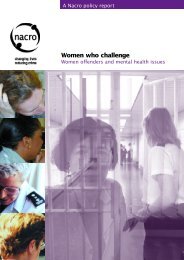Looking at employment - Nacro
Looking at employment - Nacro
Looking at employment - Nacro
You also want an ePaper? Increase the reach of your titles
YUMPU automatically turns print PDFs into web optimized ePapers that Google loves.
MEDIATINGfor a Safer SocietyBY STEPHANIEBRAITHWAITEPhoto: Stuart RaynerMedi<strong>at</strong>ion is a method of conflict resolution th<strong>at</strong> enables peopleinvolved in a conflict to reach a mutually acceptable agreement withthe help of a trained, neutral third party medi<strong>at</strong>or.MEDIATION UK is a registered charity and the onlyumbrella organis<strong>at</strong>ion in the UK for projectsinvolving medi<strong>at</strong>ion, conflict resolution andaccredited training. The main areas of its work arein the local community to help solve neighbourhood conflicts, inschools and colleges to deal with problems such as bullying andother disruptive behaviour, and in the criminal justice system tomedi<strong>at</strong>e between the offender and his/her victim.In using medi<strong>at</strong>ion in the criminal justice system, the principlesof conflict resolution are used within the framework of‘restor<strong>at</strong>ive justice’. This has been defined by Tony Marshall, aformer Director of MEDIATION UK, as ‘a process whereby allthe parties with a stake in a specific offence come together toresolve collectively how to deal with the afterm<strong>at</strong>h of theoffence and its implic<strong>at</strong>ions for the future’.The main methods of medi<strong>at</strong>ion are: direct face-to-facemedi<strong>at</strong>ion between the victim and the offender, where theydiscuss the offence and its implic<strong>at</strong>ions, and agree on a form ofrepar<strong>at</strong>ion; and family group conferencing, where in addition tothe victim and offender, members of their families and relevantmembers of the community can come together and go throughthe same kind of processes. If direct medi<strong>at</strong>ion is not an option,then indirect medi<strong>at</strong>ion is possible, using the medi<strong>at</strong>or as a gobetween.Examples of restor<strong>at</strong>ive justice in action are the caution plusscheme and Retail Theft Initi<strong>at</strong>ive of Thames Valley Police andthe Northampton Diversion Scheme. There are obviousadvantages in using restor<strong>at</strong>ive justice methods in th<strong>at</strong> the victimcan play a direct part and have a voice in the proceedings, andthe offender is made accountable for the offence and can learnabout the impact it has had on the victim, and both can take partin deciding on repar<strong>at</strong>ion.There have been many evalu<strong>at</strong>ions of such projects, both in theUK and in other parts of the world, and the results areencouraging. Any type of crime is relevant, <strong>at</strong> any stage of thecriminal justice system. All projects have demonstr<strong>at</strong>ed alowering of reconviction r<strong>at</strong>es, from 2% in one scheme to 97%in another. But the reduction in offending behaviour is not theonly benefit. Levels of s<strong>at</strong>isfaction for both victims andoffenders are consistently high when compared with those of thenormal system. Victims are gr<strong>at</strong>eful for the opportunity to meetthe offender, to be able to express their feelings and have someinfluence on the outcome. Offenders feel they have a gre<strong>at</strong>erunderstanding of how their offence affected the victim andappreci<strong>at</strong>e the opportunity of being able to help the victim andsay they are sorry.Repar<strong>at</strong>ion can take many forms, from direct repar<strong>at</strong>ion to thevictim in terms of the return of stolen goods, financialreimbursement or a personal service to the victim of some kind,to a form of several hours’ service to the local community orcharity. Repar<strong>at</strong>ion agreements are also more likely to becompleted in full when medi<strong>at</strong>ion has been included in therepar<strong>at</strong>ion process than when it has been directly ordered by thecourt.Other findings have shown th<strong>at</strong>: medi<strong>at</strong>ion increases offenders’perception of the harm they have done to the victims; victimswant to help the offenders, especially the younger ones; bothvictims’ and offenders’ opinions of the police are morefavourable; offenders find the process more difficult thanappearing in court; many more victims take part in the processthan do in court; and fears of re-victimis<strong>at</strong>ion are decreased.Safer communities can be built by reductions in crime and fearof crime and also by involving and enabling members of thecommunity to solve their own problems, as all forms ofmedi<strong>at</strong>ion <strong>at</strong>tempt to do.Further opportunities for medi<strong>at</strong>ion involving the police,prob<strong>at</strong>ion officers, social workers and local youth justice teamswill arise as a result of the Crime and Disorder Act 1998,especially with the introduction of final warnings, repar<strong>at</strong>ion,action plan and supervision orders. Stephanie Braithwaite is a chartered forensic psychologistworking with MEDIATION UK as a volunteer.Recent developments in all the forms of medi<strong>at</strong>ion -including community, educ<strong>at</strong>ion, victim-offender,environmental, workplace and intern<strong>at</strong>ionalrel<strong>at</strong>ions - will be discussed <strong>at</strong> the MEDIATION UKAnnual Conference in Sheffield from 17 to 19 June1999. For further details about the work ofMEDIATION UK or the conference, please contactTherese Windle <strong>at</strong> MEDIATION UK, Alexander House,Telephone Avenue, Bristol BS1 4BS. Tel: (0117) 9046661. Fax: (0117) 904 3331. Email:medi<strong>at</strong>ionuk@medi<strong>at</strong>ionuk.org.ukSee news item on NACRO’s feport on medi<strong>at</strong>ion on page 8.NACRO SAFER SOCIETY MAGAZINE FEBRUARY 1999 24
















